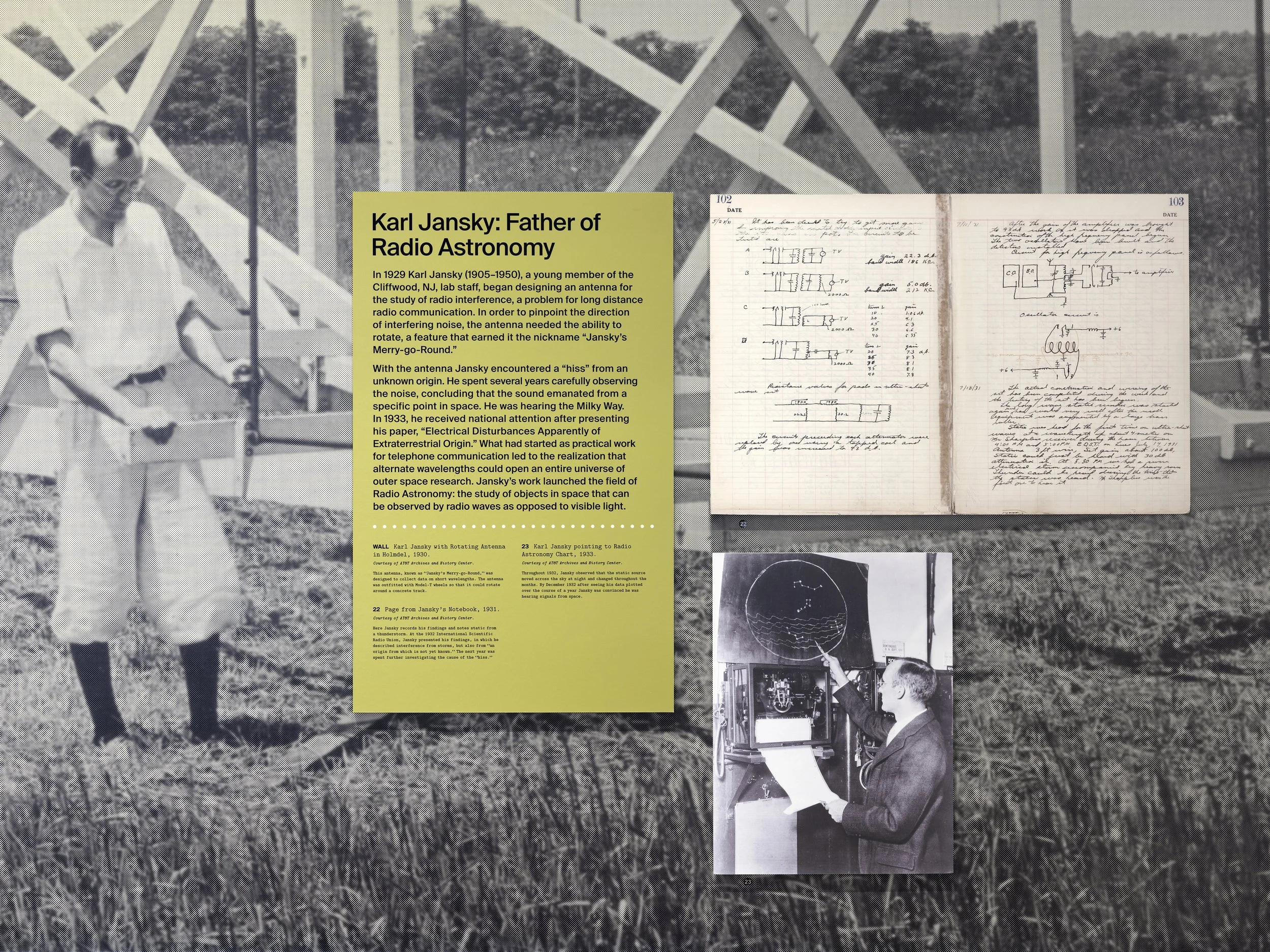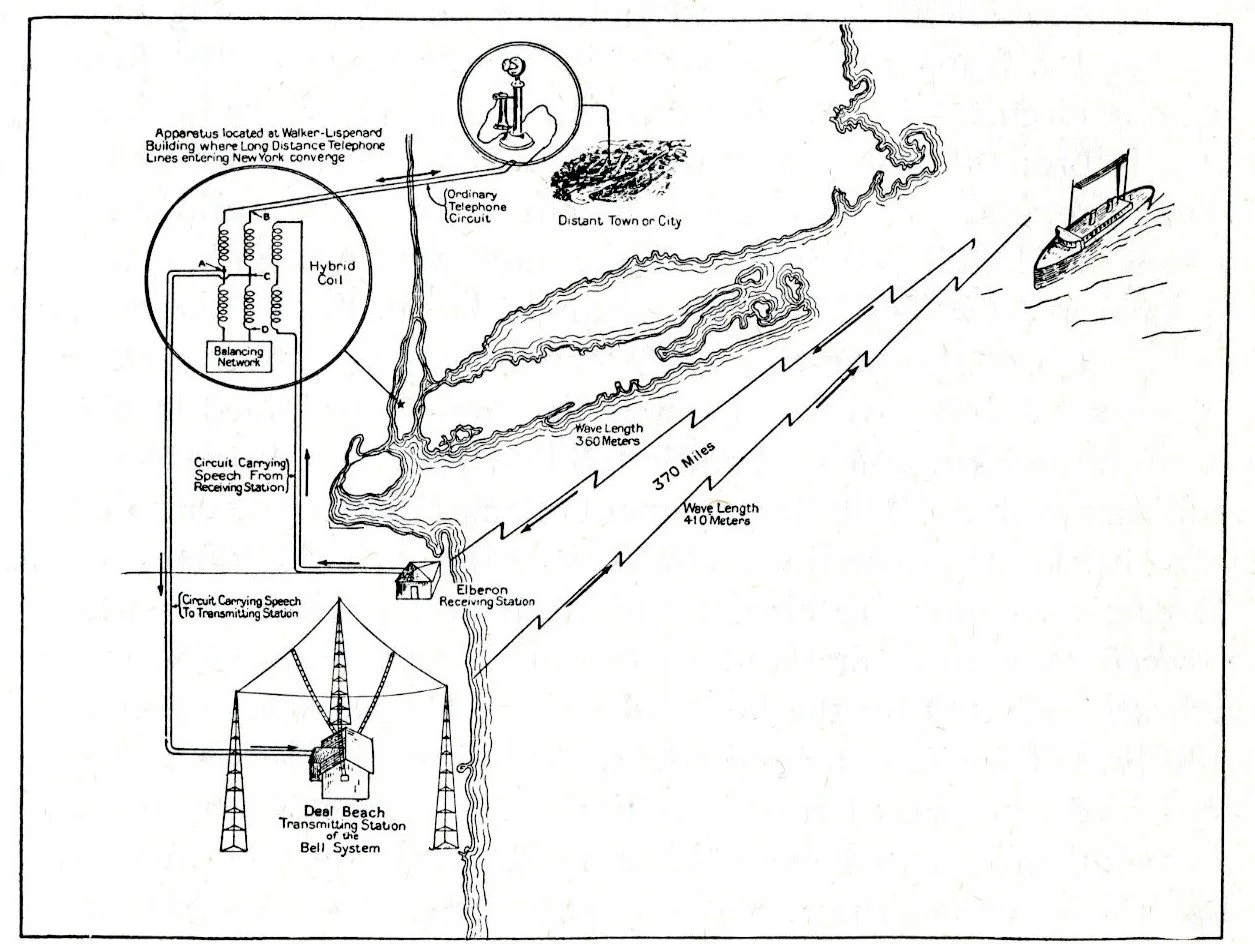Gallery 3
Click here to head back to the Ma Bell landing page.
Going Wireless at the Jersey Shore
Radio Extension to Ships at Sea from Deal, NJ, 1923, Bell System Technical Journal.
Collection of Prelinger Library in San Francisco, CA.
By transmitting voice wirelessly, AT&T could extend phone service to ships at sea. Engineers could not experiment in AT&T’s Manhattan labs due to the interference caused by the telegraph signals. In the fall of 1919, Western Electric purchased land in Cliffwood, Holmdel, Elberon, and Oakhurst (also known as Deal Test Site). It was at the Deal Test Site that Bell System engineers perfected ship-to-shore communication.
In the following decade, Ocean Gate and it’s sister shore station at Forked River were built in the salt marshes of Barnegat Bay. Calls placed from ships at sea were received in Forked River where they were transferred from wave to wire on machines inside the building, and then carried via wire to New York where an operator would connect them. Outgoing calls would be transmitted via radio to a ship from Ocean Gate. Another receiving station built in Manahawkin, NJ was also completed in 1939.
Click here to learn more about going wireless.
Ground-to-Air Communication
Airplane technology was still in development after the turn of the twentieth century. Early pilots relied on hand signals and flags for communication. A partnership between the Signal Corps of the US Army and Western Electric fostered rapid wartime advancement, ushering in an era of mutually beneficial alliances between the Bell System and US Military.
In the midst of war, the Signal Corps needed to quickly expand their ranks of men with telephone and telegraph experience. In 1916, they approached Theodore Vail about recruiting Bell employees. Enlisted Bell men were funneled to Signal Corp training camps, including Camp Alfred E. Vail in Monmouth County, NJ.
The Signal Corps also asked Western Electric to develop an airplane radio set. Within just six weeks field tests at Langley Field, Virginia were successful with the first air-to-ground transmission completed at a distance of two miles. Three days later, the Signal Corps accomplished the reverse: ground-to-air. By August, communication was possible between planes. Further experimentation continued at NJ airfields, like Hadley Field in South Plainfield.
To learn more about women in the Signal Corps, Meet the “Hello Girls” with former Army Historian Melissa Ziobro.
Click here to learn more about Ground-to-Air Communication.
Aviation radio test, probably Hadley Field, South Plainfield, NJ, 1917. Morris Rosenfeld, photographer.
Collection of AT&T Archives and History Center.
The First Television Transmission
Sketch of television demonstration, 1927.
Collection of AT&T Archives and History Center.
In 1927, the first transmission of live broadcast television took place. Herbert Hoover (then Secretary of Commerce) spoke from Washington D.C. to a New York audience. At AT&T’s 3XN Whippany Station in NJ, also broadcasting to New York, performers of a variety of talents provided content to broadcast and a narrator explained to the guests exactly what they were witnessing.
The President of AT&T Walter S. Gifford remarked, “We shall see the fruition of years of study on the problem of seeing at a distance as though face to face.” Researchers had been working towards this moment for decades. Engineers needed solutions for rotating the special transmitting and receiving discs at the same speed and for converting a moving image into an electric current.
It was not until the end of the 1930s that the quality of transmittable moving pictures was good enough to produce commercially viable programming. Once this was possible production started on television receiver sets for private use.
Click here to learn more about Early Television.
Karl Jansky: Father of Radio Astronomy
Karl Jansky with Rotating Antenna in Holmdel, 1930.
Collection of AT&T Archives and History Center.
In 1929 Karl Jansky (1905–1950), a young member of the Cliffwood, NJ lab staff, began designing an antenna for the study of radio interference, a problem for long distance radio communication. In order to pinpoint the direction of interfering noise, the antenna needed the ability to rotate, a feature that earned it the nickname “Jansky’s Merry-go-Round.”
With the antenna Jansky encountered a “hiss” from an unknown origin. He spent several years carefully observing the noise, concluding that the sound emanated from a specific point in space. He was hearing the Milky Way. In 1933, he received national attention after presenting his paper, “Electrical Disturbances Apparently of Extraterrestrial Origin.” What had started as practical work for telephone communication led to the realization that alternate wavelengths could open an entire universe of outer space research. Jansky’s work launched the field of Radio Astronomy: the study of objects in space that can be observed by radio waves as opposed to visible light.
Click here to learn more about Karl Jansky.
Lawrenceville, NJ: Radio Gateway to the World
Photograph of Transmitter Building 1 with Sterba antennas and the first rhombic antenna, 1935.
Collection of AT&T Archives and History Center.
Beginning in 1929, any call placed to Europe, the Middle East, or Africa was transmitted through Lawrenceville, NJ. In 1928, the Bell System purchased land in Hopewell and Lawrence townships for a radio transmission site, locally known as the “Pole Farm.” This 820 acre tract was chosen for its flatness and distance from the criss-crossing telegraph signals of New York City. AT&T erected thousands of poles, each 80 feet high or more, to become the world’s largest radiotelephone shortwave transmitting station. Lawrenceville’s receiving sister station was located 50 miles away in Netcong, NJ.
At the height of its operation, the pole farm employed 80 radio men, who worked to keep the transmitters running, constantly replacing burnt out vacuum tubes. Outdoor equipment was maintained by linemen or “riggers.”
With the laying of the transatlantic cable in the 1950s, more reliable calls to Europe could now be made over wire instead of radio. In 1973 AT&T closed the station. Today it is part of the Mercer County Parks System.
Click here to learn about Lawrenceville and Radios.
Click here to move to the next room in this exhibition, Gallery 4.










